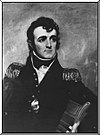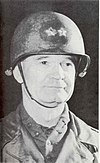| Name | Class year | Notability | References |
|---|
| Joseph Gardner Swift | 1802 | Brigadier general; first graduate of the Academy; War of 1812; Superintendent of the Academy (1812–1814); Chief of Engineers (1812–1818) | [1] |
| Walker Keith Armistead | 1803 | Brigadier general; War of 1812; Chief of Engineers (1818–1821) | [1] |
| Joseph Gilbert Totten | 1805 | Major general; War of 1812, Mexican–American War, American Civil War; military and lighthouse engineer; Chief of Engineers (1838–1864) | [1] |
| Charles Gratiot | 1806 | Brigadier general; War of 1812; Chief of Engineers (1828–1838) | [1] |
| Richard Delafield | 1818 | Major general; 7th, 11th, and 13th Superintendent of the Academy (1838–1845), (1856–1861), (1861); American Civil War; Chief of Engineers (1864–1866) | [1] |
| George Washington Whistler | 1819 | Major (United States); Chief Engineer that constructed the railroad between St. Petersburg and Moscow, Russia (1842); Received the Order of St. Anne from the Czar Nicholas (1847); father of the painter James Abbott McNeill Whistler (1834) | [1] |
| Isaac R. Trimble | 1822 | Major General CSA; civil and railroad engineer; wounded and captured at the Battle of Gettysburg | [a][b][2] |
| George S. Greene | 1823 | Brigadier general; second cousin of General Nathanael Greene of the American Revolutionary War; railroad and aqueduct engineer, founder of American Society of Civil Engineers and Architects; defender of Culp's Hill during the Battle of Gettysburg | [b][3][self-published source] |
| Andrew A. Humphreys | 1831 | Major general; American Civil War; topographical and hydrological surveyor of the Mississippi River Delta; Chief of Engineers (1866–1875); an incorporator of the United States National Academy of Sciences | [1] |
| Herman Haupt | 1835 | Brigadier general; railroad engineer and head of the United States Military Railroad during the American Civil War | [4] |
| John Williams Gunnison | 1837 | Captain; topographical engineer; supervised one of the Pacific Railroad surveys in 1853; Gunnison, Colorado and Gunnison, Utah are named in his honor | [5][6] |
| Horatio Wright | 1841 | Major general; American Civil War; Chief of Engineers (1879–1884) | [1] |
| John Newton | 1842 | Brigadier general; American Civil War; coastal fortifications engineer; Chief of Engineers (1884–1886) | [1] |
| John Pope | 1842 | Major general; topographic engineer and surveyor; Dakota War of 1862, Apache Wars; defeated at the Second Battle of Bull Run, commander of Army of the Mississippi and Army of Virginia | [b][7] |
| William F. Raynolds | 1843 | Colonel; topographic engineer; Mexican–American War; American Civil War; lighthouse construction, led 1859–1860 Raynolds Expedition in Yellowstone region. | |
| James Chatham Duane | 1848 | Brigadier general; leader of engineers in the Utah War of 1858; American Civil War; coastal fortifications and pontoon engineer; Chief of Engineers (1886–1888) | [1] |
| Robert S. Williamson | 1848 | Lieutenant colonel; American Civil War; topographical engineer; participated in the Pacific Railroad Surveys | [6] |
| John Parke | 1849 | Major general; American Civil War; participated in the Pacific Railroad surveys in 1853; chief surveyor who delineated the boundary between northwestern United States and British North America; Superintendent of the Academy (1887–1889) | [8] |
| Rufus Saxton | 1849 | Brigadier general; recipient of the Medal of Honor for his defense at the Battle of Harpers Ferry; participated in the Pacific Railroad surveys in 1853; early abolitionist | [9][10] |
| Gouverneur K. Warren | 1850 | Major general; commended at the battle of Little Round Top, Chief of Engineers of the Army of the Potomac during the American Civil War; participated in topographical and railroad explorations of the Mississippi River and trans-Mississippi West | [11] |
| Thomas Lincoln Casey | 1852 | Brigadier general; American Civil War; fortifications engineer; construction engineer of the Washington Monument and Old Executive Office Building; Chief of Engineers (1888–1895) | [1] |
| William Price Craighill | 1853 | Brigadier general; American Civil War; fortifications, river, harbor, and coastal engineer; author; Chief of Engineers (1895–1897) | [1] |
| Orlando Metcalfe Poe | 1856 | Brigadier general; American Civil War; lighthouse, harbor, and river engineer; responsible for much of the early lighthouse construction on the Great Lakes; built the Poe Lock of the Soo Locks in Sault Ste. Marie, Michigan; Poe Reef Light in Lake Huron is named in his honor | [12] |
| Henry Martyn Robert | 1857 | Brigadier general; Pig War; American Civil War; fortifications, river, and harbor engineer; wrote Robert's Rules of Order; Chief of Engineers (1901) | [1] |
| John Moulder Wilson | 1860 | Brigadier general; recipient of the Medal of Honor for his actions at the Battle of Malvern Hill despite acute illness; Superintendent of the Academy (1889–1893); Chief of Engineers (1897–1901) | [1][9] |
| John W. Barlow | 1861 | Brigadier general; American Civil War; participated in topographical explorations of the headwaters of the Missouri River and Yellowstone River; Chief of Engineers (1901) | [1] |
| George Lewis Gillespie, Jr. | 1862 | Brigadier general; recipient of the Medal of Honor for carrying dispatches under withering fire at the Battle of Cold Harbor; fortification and pontoon engineer; Chief of Engineers (1901–1904) | [1][13] |
| David Porter Heap | 1864 | Brigadier general; engineer and author; harbor and lighthouse engineer | [14] |
| Alexander Mackenzie | 1864 | Major general; American Civil War; torpedo, river, and harbor engineer; Chief of Engineers (1904–1908) | [1] |
| William Louis Marshall | 1868 | Brigadier general; topographic and river engineer; Chief of Engineers (1908–1910) | [1] |
| William Herbert Bixby | 1873 | Brigadier general; coastal and river engineer; Chief of Engineers (1910–1913) | [1] |
| William Trent Rossell | 1873 | Brigadier general; fortification, harbor and river engineer; Chief of Engineers (1913) | [1] |
| Dan Christie Kingman | 1875 | Brigadier general; fortification, harbor and river engineer; Chief of Engineers (1913–1916) | [1] |
| William Murray Black | 1877 | Major general; Spanish–American War; civil engineer; Chief of Engineers (1917–1919) | [1] |
| George Washington Goethals | 1880 | Major general; chief engineer of the Panama Canal; Governor of the Panama Canal Zone (1914–1917) | [15] |
| Lansing Hoskins Beach | 1882 | Major general; river, harbor, and coastal engineer; Chief of Engineers (1920–1924) | [1] |
| Harry Taylor | 1884 | Major general; World War I; fortification, river, and harbor engineer; Chief of Engineers (1924–1926) | [1] |
| Edgar Jadwin | 1890 | Major general; Spanish–American War; World War I; river, bridge, and road engineer; Chief of Engineers (1926–1929) | [1] |
| Lytle Brown | 1898 | Major general; Spanish–American War; Pancho Villa Expedition; World War I; civil engineer; Chief of Engineers (1929–1933) | [1] |
| Edward Murphy Markham | 1899 | Major general; World War I; topographic and civil engineer; Chief of Engineers (1933–1937) | [1] |
| Julian Larcombe Schley | 1903 | Major general; World War I; topographic and civil engineer; Governor of the Panama Canal Zone (1932–1926); Chief of Engineers (1937–1941) | [1] |
| Raymond Albert Wheeler | 1911 | Lieutenant general; World War II; railroad and highway engineer; Chief of Engineers (1945–1949); directed the clearing of the Suez Canal following the 1956 Suez Crisis | [1][16] |
| Lunsford E. Oliver | 1913 | Major general; initiated the research that led to the development of the steel treadway bridge; Commander of 5th Armored Division during World War II | [17] |
| Hugh John Casey | 1918 | Major general; instructor and engineer company commander during World War I; Chief Engineer for General of the Army Douglas MacArthur for the South West Pacific theatre of World War II; initial designer of The Pentagon; father of Major Hugh Boyd Casey; father-in-law of Major General Frank Butner Clay | [18] |
| Samuel D. Sturgis, Jr. | 1918 | Lieutenant general; World War II; railroad and highway engineer; Chief of Engineers (1953–1956) | [1] |
| Emerson C. Itschner | 1924 | Lieutenant general; World War II; Korean War; civil engineer; Chief of Engineers (1956–1961) | [1] |
| Walter K. Wilson, Jr. | 1929 | Lieutenant general; World War II; Chief of Engineers (1961–1965) | [1] |
| William F. Cassidy | 1931 | Lieutenant general; World War II; airfield engineer and engineer logistician; Chief of Engineers (1965–1969) | [1] |
| Frederick J. Clarke | 1937 | Lieutenant general; World War II; airfield engineer, engineer logistician, and early developer of the Red Ball Express; worked on the Manhattan Project; Chief of Engineers (1969–1973) | [1] |
| William C. Gribble, Jr. | 1941 | Lieutenant general; World War II; civil and nuclear engineer; worked on the Alaska Highway; Chief of Engineers (1973–1976) | [1] |
| John W. Morris | 1943 | Lieutenant general; World War II, Korean War, Vietnam War; airfield and river engineer; Chief of Engineers (1976–1980) | [1] |
| Joseph K. Bratton | 1948 | Lieutenant general; Korean War, Vietnam War; Chief of Engineers (1980–1984) | [1] |
| Fidel V. Ramos | 1950 | General; Korean War, Vietnam War; master's degree in civil engineering at the University of Illinois (1951); Chief of Staff of the United Nations engineering contingent during the Vietnam War | [19] |
| Elvin R. Heiberg III | 1953 | Lieutenant general; Vietnam War; held three Master's degrees; Chief of Engineers (1984–1988) | [1] |
| Henry J. Hatch | 1957 | Lieutenant general; Vietnam War; Paratrooper and Army Ranger; Chief of Engineers (1988–1992) | [1] |
| Robert L. Van Antwerp, Jr. | 1972 | Lieutenant general; Gulf War; Paratrooper and Army ranger; Chief of Engineers (2007–present) | [1] |









